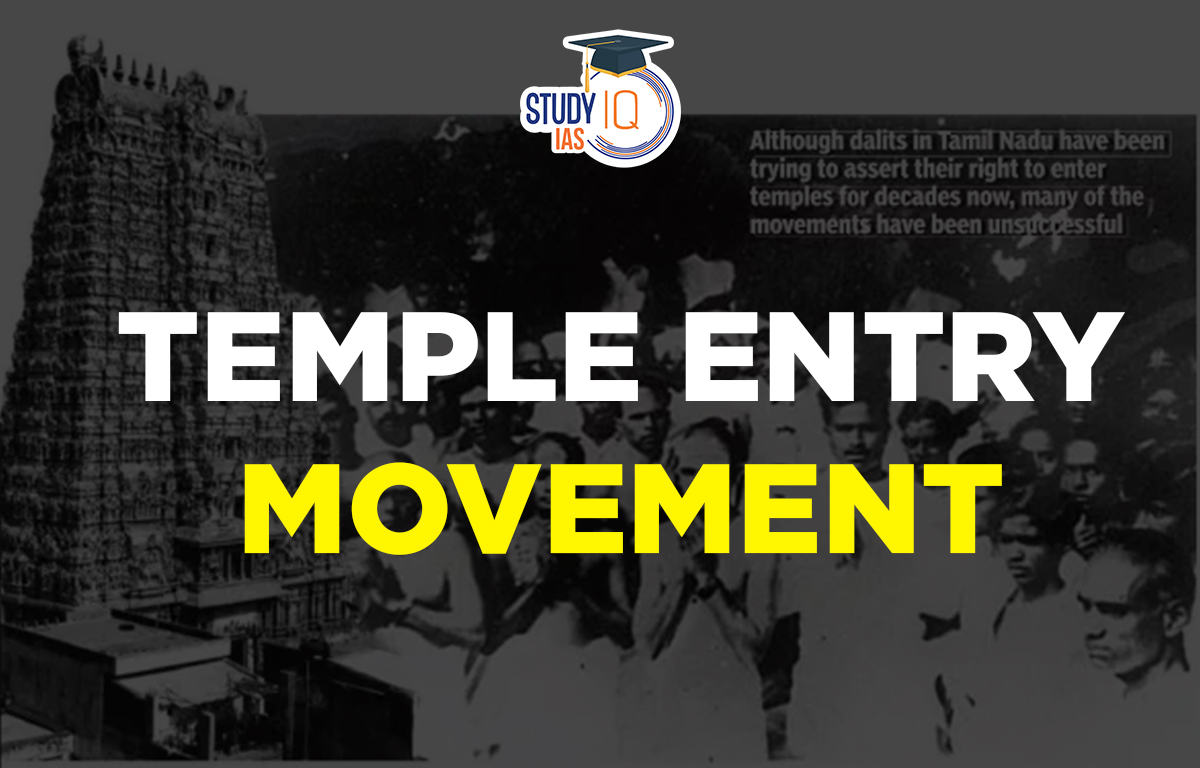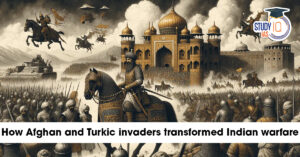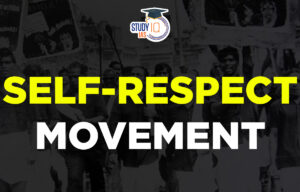Table of Contents
Temple Entry Movement
Bhimrao Ambedkar founded the Temple Entry Movement as a nationwide strategy to combat caste injustice. Hindu societal change was the primary objective. In Kerala in the 20th century, the poor were forbidden from entering temples. It was started with the intention of opening all Hindu temples while waging a large propaganda effort to promote social advancement and the untouchability of members of lower castes. In this aticle student preparing for UPSC will get all the details about temple entry movement for UPSC Exam Preparations.
Read about: Khilafat Movement
Temple Entry Movement History
Throughout its history, India has seen a number of temple admission movements and attempts to abolish the caste system. Sri Narayana Guru started the Aravipuram movement as a response to caste and Brahmanical supremacy. At Aruvippuram, he constructed a temple honouring Lord Shiva in defiance of the era’s caste-based limitations.
The Vaikom Satyagraha was a large-scale protest led by Ramaswamy Periyar that called for the right of lower caste individuals to utilise a public route in front of the well-known Vaikom temple. It was successful in making the roads around the shrine accessible to them. To allow access of all castes into temples, a Satyagraha was staged in Guruvayur by a coalition of the lowest caste Harijans and the highest caste Namboodiris. Kelappan worked tirelessly until his death to let everyone into the temple.
Read about: Justice Movement
Temple Entry Movement First Struggle
The avarnas (Harijans), or lower classes in Kerala, experienced degrading and dehumanising social disabilities. For instance, because to untouchability or distance pollution, the Ezhavas and Pulayas were unable to get close to members of higher castes any closer than 16 feet and 72 feet, respectively.
Since the end of the nineteenth century, a number of reformers and intellectuals, including Sri Narayan Guru, N. Kumaran Asan, and T.K. Madhavan, have been struggling against these obstacles. Following the Kakinada session, the Kerala Provincial Congress Committee (KPCC) immediately regarded the abolition of untouchability as an important matter.
It was decided to start a movement right away to allow Harijans and other avarnas access to Hindu temples and all public roads while also waging a significant propaganda war against untouchability and for the Harijans’ social and scholastic advancement.
Read More: Social Service League
Temple Entry Movement Second Struggle
A beginning was made at the Travancore village of Vaikom. There was a sizable temple with four walls there, and avarnas like Ezhavas and Pulayas were prohibited from using the temple roads that surrounding it. On March 30, 1924, the KPCC decided to fight untouchability using the newly acquired tactic of satyagraha. At Vaikom, they disobeyed the inapproachability order by leading a procession of caste Hindus by savarnas and avarnas around the temple paths.
Political and social activists were immediately excited to learn about the Satyagraha, which spurred a tremendous effort to stir up savarnas’ consciousness and enlist their active support. Numerous savarna organizations, such as the Kerala Hindu Sabha, Nair Service Society, and Nair Samajam, supported the Satyagraha.
Avarnas entering temples was supported by the Yogakshema Sabha, the leading organisation of the Namboodiris (the highest caste of Brahmins). The entry roads to the temple were blocked off by temple officials and the Travancore government, and the District Magistrate issued restraining orders against the Satyagraha’s leaders.
On March 30, K.P. Kesava Menon led the Satyagrahis as they marched from the Satyagraha camp to the temple. As with the successive batches of Satyagrahis, who contained both savarnas and avarnas, they were apprehended and given prison terms. Widespread interest in the Vaikom Satyagraha led to the arrival of volunteers from all around India. An Akali jatha from Punjab arrived. E.V. Ramaswami Naicker (Periyar) was jailed for leading a jatha from Madurai.
On the other hand, the traditional and reactionary caste Hindus gathered at Vaikom and promised to boycott all Congressmen who supported satyagraha, refusing to vote for them or hire them as teachers or lawyers. After the Maharaja passed away in August 1924, the Maharani, in her capacity as Regent, freed all the Satyagrahis. The response to this act of kindness was well received, therefore it was decided to organise a jatha (a group of volunteers) of caste Hindus to ask the Maharani to open the temple roads to everyone.
Hindus of all castes descended on Vaikom in their thousands from all over Kerala. A jatha of about 100 caste Hindus started their foot march to Trivandrum on October 31. Along the process, about 200 villages and municipalities embraced it. By the time it reached Trivandrum, it had expanded to around 1,000 individuals. The Satyagraha continued as a result of the Maharani’s refusal to give in to their demand.
Early in March 1925, when he first met the Maharani and other authorities, Gandhi started his trek through Kerala. There was an agreement reached. Roads outside the temple were made accessible to avarnas, while those inside the Sankethan of the temple remained blocked. Gandhi did not go to a single temple during his travels through Kerala since avarnas were not allowed.
The struggle against untouchability and for the social and economic advancement of the underprivileged persisted throughout India after 1924 as a result of Gandhi’s constructive vision. Kerala was once more involved in a bloody conflict. K Kelappan prompted the KPCC to address the problem of temple admittance in 1931 after the suspension of the Civil Disobedience Movement.
Read More: Self-Respect Movement
Temple Entry Movement Satyagraha in Guruvayur
The “Singing Sword of Kerala” poet Subramanian Tirumambu organised a jatha of sixteen volunteers who marched from Cannanore in the north to Guruvayur on October 21. The volunteers came from all social classes, ranging from Namboodiris, the highest caste, to the lowest caste Harijans. The march provoked nationwide outrage and heightened anti-caste sentiment. The first of November was cordially observed as All-Kerala Temple Entry Day, with a schedule of prayers, processions, gatherings, receptions, and money collections.
It was noted in a number of cities, including Madras, Bombay, Calcutta, Delhi, and Colombo (Sri Lanka). The general public’s response was largely favourable. Numerous Indian leaders travelled to Malabar. From all around the world, donations and volunteers poured in. The combat was particularly drawn to the youth, who led the charge. The idea of untouchability has gained appeal.
Many devotees changed their contributions from the temple to the Satyagraha camp because they thought the camp was even more sacred than the shrine. The temple’s administrators also made preparations. They constructed barbed wire around the shrine and formed watchmen gangs in order to stop the Satyagrahis from entering and to threaten them with beatings.
On November 1, sixteen volunteers dressed in white khadi marched to the eastern gate of the temple, where they were stopped by a posse of police officers commanded by the superintendent of police, who barred their path. Temple staff and local reactionaries started using physical force on the calm and nonviolent Satyagrahis as the police watched in silence.
For instance, P Krishna Pillai and A.K. Gopalan, who later rose to prominence as leaders of the Communist movement in Kerala, were brutally beaten. The Satyagraha persisted even after the Civil Disobedience Movement was restarted in January 1932, all Congress Committees were considered illegal, and the majority of the Congressmen who organised the Satyagraha were jailed.
On September 21, 1932, K. Kelappan began a life-defying fast in front of the temple until it was made accessible to the poor, which gave the Satyagraha a new direction. Once more, the entire nation was shaken to the core. Meetings and processions once more engulfed Kerala and many other regions of the nation. Hindus of all castes from Kerala and the rest of India petitioned the Zamorin of Calicut, who looked after the temples, to provide access to all Hindus, but in vain.
Gandhiji persuaded Kelappan to break his fast, at least momentarily, and made a pledge that he would personally take up the duty of reopening the temple if it became necessary. Finally breaking his fast, Kelappan did so on October 2, 1932. Additionally, the Satyagraha movement was suspended. On the other hand, the admissions drive for the temple was stepped up. A.K. Gopalan led a jatha that travelled the entire length and breadth of Kerala while delivering speeches and disseminating propaganda. Before being disbanded, the jatha had travelled roughly a thousand miles and spoken at more than 500 sessions.
Read More: Reform Movements in Southern India
Temple Entry Movement Success
Even though the Guruvayur temple took some time to open, the Satyagraha was ultimately quite successful. In his autobiography, A.K. Gopalan writes, “Even though the Guruvayur temple was still closed to Harijans, I realised that the movement had provided an impetus for social change throughout the country.”
The temple admission movement made use of every tactic the Indian people had acquired during the nationalist struggle. The campaign’s organisers were successful in attaining the greatest degree of unanimity, delivering widespread education, and mobilising the public on a significant scale over the untouchability issue. Temple access alone would not be sufficient to address the complex and deeply ingrained problem of caste injustice, oppression, and degrading treatment. However, Satyagrahas like those in Guruvayur and Vaikom, as well as the movements that supported them, significantly aided in this effort.
E.M.S. Namboodiripad later noted that the Guruvayur Temple Satyagraha “enthralled thousands of young men like me and supplied impetus to a huge majority of the people to strive for their lawful rights with self-respect.” The same youths who took this risky step forward later established worker-peasant organisations free from religion or communal prejudice.”
The main problem with the temple entry campaign and the Gandhian or nationalist approach to combating caste oppression was that, despite entertaining the populace against untouchability, they had a plan for eliminating the caste system itself. The independent Indian Constitution, which ended caste discrimination, outlawed untouchability, and ensured social equality for all people, regardless of caste, was one way that the national movement found expression in this regard. The emergence of casteism and the ongoing persecution and discrimination of the lower castes in post-independence India are examples of its shortcomings.
Read More: Paramahansa Mandali
Temple Entry Movement UPSC
The strategies created during the nationalist fight were applied by the temple admission movement. The Gandhian or nationalist strategy used by the temple entry campaign to combat caste discrimination. In response to the campaign, the Maharaja of Travancore declared in November 1936 that all government-run temples would be open to all Hindus, regardless of caste. Madras also followed suit. This article has all the details about Temple Entry Movement for UPSC Exam Preparations.
Read More: Prarthana Samaj


 Birsa Munda Birth Anniversary 2025: Life...
Birsa Munda Birth Anniversary 2025: Life...
 Military Innovations of Afghans and Turk...
Military Innovations of Afghans and Turk...
 Self-Respect Movement, History, Objectiv...
Self-Respect Movement, History, Objectiv...

























